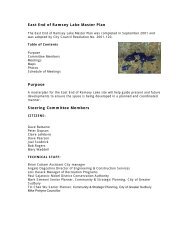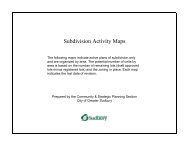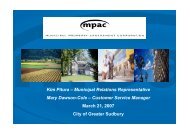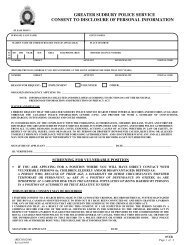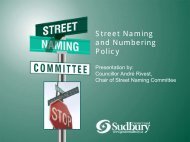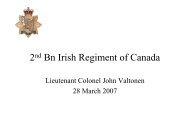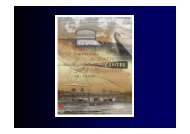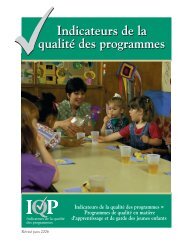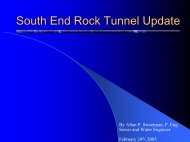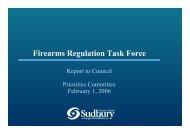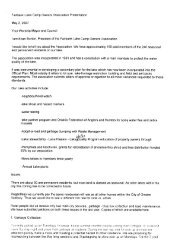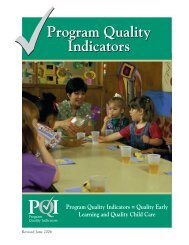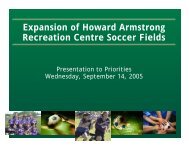City of Greater Sudbury Transportation Study Report
City of Greater Sudbury Transportation Study Report
City of Greater Sudbury Transportation Study Report
You also want an ePaper? Increase the reach of your titles
YUMPU automatically turns print PDFs into web optimized ePapers that Google loves.
For all other trips (i.e. external trips either traveling through <strong>Greater</strong> <strong>Sudbury</strong> or having an<br />
origin or destination outside <strong>Greater</strong> <strong>Sudbury</strong>) a base year p.m. peak hour external trip table<br />
was developed using the household survey records, the external trip table from the 1992<br />
<strong>Transportation</strong> <strong>Study</strong>, traffic counts, and a procedure in TransCAD which generates trip<br />
tables based on partial survey information and traffic counts.<br />
Although there are several methods for performing trip distribution, a gravity model was<br />
deemed the most appropriate method for the <strong>Greater</strong> <strong>Sudbury</strong> model for internal trips. The<br />
determination <strong>of</strong> the number <strong>of</strong> trips between traffic zones becomes a function <strong>of</strong> the number<br />
<strong>of</strong> trip productions at the origin zone, the number <strong>of</strong> trip attractions at the destination, and<br />
some function <strong>of</strong> travel between the zones, which in the case <strong>of</strong> <strong>Greater</strong> <strong>Sudbury</strong> is travel<br />
time. The general form <strong>of</strong> the gravity model is shown in the following equations:<br />
Tij = Ai* Bj* Oi* Dj* Fij<br />
Where Tij= Trip interchanges between origin zone I and destination zone j,<br />
Oi= Total trip productions at origin zone I<br />
Dj= Total trip attractions at destination zone j,<br />
f(t(ij))= Travel deterrence function, in the case <strong>of</strong> <strong>Sudbury</strong> it is an inverse<br />
exponential function <strong>of</strong> time defined as;<br />
f(t(ij))= e -ßt(ij)<br />
Where ß= a calibration parameter,<br />
t(ij)= auto travel time from zone i to zone j<br />
A,B = balancing factors<br />
With this form <strong>of</strong> the gravity model, as travel time between zones increases, the number <strong>of</strong><br />
trips between those traffic zones decreases.<br />
Typically, home based work (HBW) trips have different trip making characteristics than home<br />
based other trips and non home based trips and for this reason it was decided to calibrate<br />
two gravity models for internal trips. This means that a ß parameter needs to be calibrated<br />
for HBW trips and another for all other trips (i.e. home based other and non-home based<br />
trips).<br />
The TransCAD s<strong>of</strong>tware has a built-in routine for calibrating gravity models and this was<br />
used to determine the parameters to be used in the gravity models. A p.m. peak hour<br />
travel time matrix, and p.m. peak hour trip observed tables for both purposes are required to<br />
perform this task. These calibrated parameters are as follows:<br />
Home Based Work - ß = 0.0370<br />
All Other trips - ß = 0.0412<br />
CITY OF GREATER SUDBURY<br />
OFFICIAL PLAN BACKGROUND REPORT<br />
September 2005 Page 47



